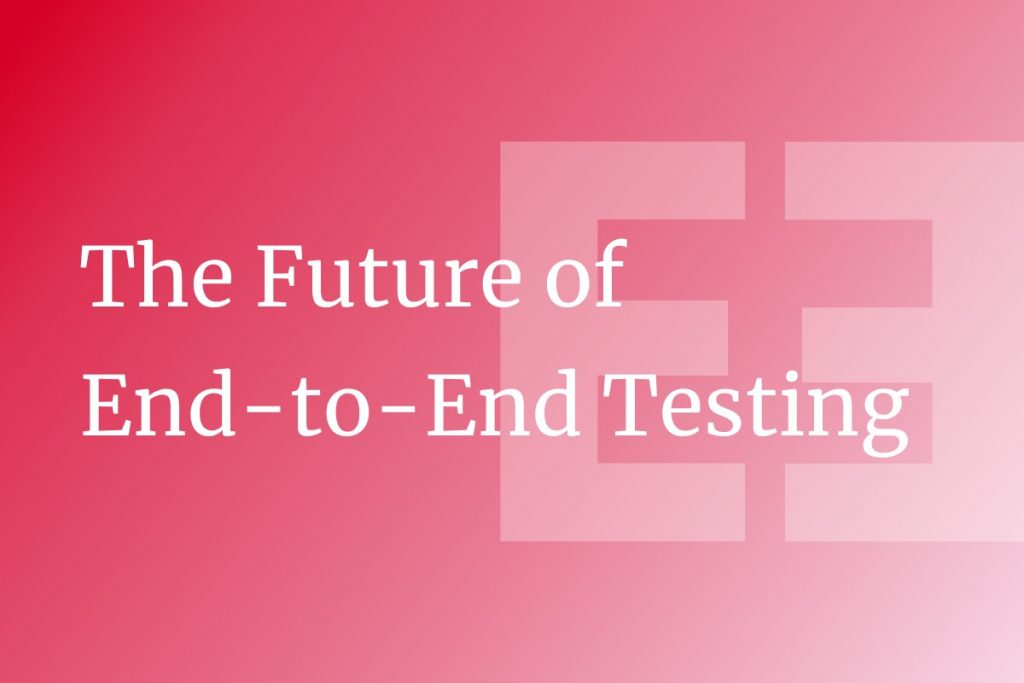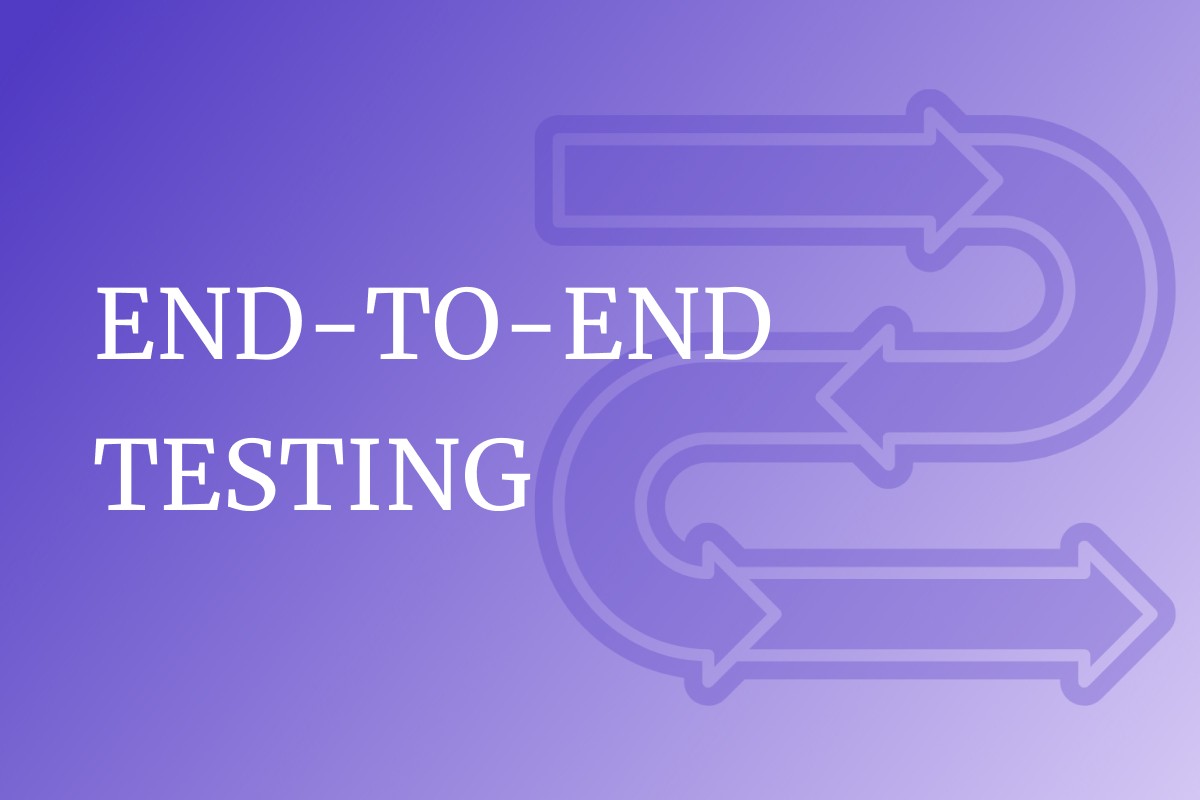Software testing sometimes sounds oddly provoking, or does it not? Depending on the nature of your software products, you might have to plan out a handful of testing types and approaches to get all your code bases covered. As we move forward with our product development, or per se, we take our stand on the software industry long enough; we’ll be able to identify which testing methodologies work out best and bypass others that do not contribute optimal benefits to your finished products.
Today’s topic will be religiously discussing the spectrum of end-to-end testing (so-called E2E testing). First thing first, what is your take on E2E testing?
E2E Testing – your product’s reality check
End-to-end testing is most likely implemented toward the end of the software development cycle as soon as the product is profoundly finished. It mimics the real users’ interaction with the products from their perspective in order to evaluate their performance under real-world conditions and environments.
Does that sound familiar? It might!
Since the testing approach is pretty similar to User Acceptance Testing (UAT testing), instead of carrying out the testing by business users like UAT testing, E2E testing would be carried out by the technical testers ( or you might call them the QA team). Although the E2E testing would only be done before the product’s release, it’s not necessarily the last testing stage. E2E testing usually starts after integration testing and before the UAT testing period.
In short, E2E testing helps to validate your product’s process flow from beginning to end. Rather than checking at the individual part, like how unit testing would E2E testing examine the product software application as a whole. Like how you would a pen manufacturer company would interrogate their pen at the end of the production line, not just focus on whether or not the pen works, but also focus on how the end-user would feel when they hold the pen in their hands, how smooth the ink flows, does the pen nib feel a bit scratchy while writing, and so on. E2E accesses all the component interactions altogether and evaluates the process flow to verify whether the products meet its predefined operation requirements.
We have briefly discussed E2E testing in the previous blog, which you can find here at End-to-End Testing: A Comprehensive E2E Testing Full Guide, for more reading on this topic.

E2E Testing Challenges
Building software might start from individual unit components; it would not work with this unit isolation separately but rather with them working in conjunction with each other. Plus, there are dependencies of having them connected with other components in the industry due to the complex needs of the end-users. It creates numerous unforeseeable variables and potential failure for E2E testing. Challenges are obviously just unavoidable.
E2E testing can be time-consuming
Remember, E2E testing is often carried out after the product is somewhat built decently, so you have to wait for E2E testing to start. That’s not all. Creating test suites and aligning them with the user’s navigation within the application may involve running thousands of tests and relocating resources to get the work done, resulting in extra tight deadlines that are impossible to meet.
Automation can be applied in these situations. However, automation testing tools can be unreliable at times. It requires constant updates, modifications, and monitoring for accuracy.
Setting up the right test environment
Accessing a proper test environment that reflects real-life scenarios is not always straightforward. It might entail needing to set up local agents and logging into virtual machines.
To minimize the challenges, adopting a cloud testing system that gives testers access to a broader range of platforms and environments to execute their tests is better, saving the initial investment into physical machines.
Difficulty in maintenance
In modern software development, where systems are frequently updated, maintaining end-to-end tests is a huge challenge. Every time the application code is changed, the test scripts must also be updated, and the effort involved is not negligible. In this context, it is extremely important to improve the reusability and manageability of test cases.
Leveraging modern tools and technologies is one solution to overcoming this challenge. For example, the Backlog report notes that modern testing frameworks can help reduce long-term costs with feature updates.
Using multiple test management tools and frameworks and establishing an efficient maintenance system is essential for continuous improvement of testing.
Best Practices for E2E Testing
Focus on your application’s critical workflows first
It’s important to prioritize critical parts of the application. Concentrate on what most people use in your application and create tests for those areas ahead of time.
After identifying the most essential workflows, begin by breaking them down into smaller steps. This gives you a more focused perspective on how your tests should be executed and reduces the number of unrelated tests.
Avoid exception testing
Exception testing is the act of testing the behavior or system when it comes across an error condition or unusual occurrence. Although it is a highly recommended practice, E2E testing is inappropriate for exception testing. This type of test might reveal that an error occurred but does not necessarily tell us why the error happened or how it will affect the application or system.
Create E2E tests that reduce UI issues
UI tests are often part of E2E tests, and they tend to fail frequently because of the unpredictable nature of interacting with the system as an end user. Problems like network delays, slow servers, and other factors can affect the test outcomes and lead to false positives. Therefore, these should be taken into account when creating E2E test cases to eliminate the possibility of unwanted UI conflicts.
Automation testing is the drill
E2E testing is different from other types of testing as it checks the application’s functionality from start to finish, covering all possible user scenarios, interactions, and interfaces. This requires extra coordination and teamwork as it tests how different modules, APIs, and systems work together.
For E2E testing, we would need more than just the regular automation tools. A platform per se is considerably better for managing software quality, as it offers a complete test management system, allowing testers to manage and organize test cases, requirements, test plans, and defects all in one place.
The future of end-to-end tesing
The future of end-to-end (E2E) testing is promising, with advancements in technology and shifts in software development methodologies. As systems become more distributed, complex, and user-centric, the demands on testing strategies will grow. Here’s a deeper dive into what lies ahead for E2E testing:
The future of end-to-end (E2E) testing looks promising, driven by advancements in technology and changes in software development methodologies. As systems become more distributed, complex, and user-centric, the demands on testing strategies will continue to grow. Here’s a closer look at what lies ahead for E2E testing:
1. Increased Automation
Automation will play a central role in the future of E2E testing. With the rise of DevOps and continuous integration/continuous delivery (CI/CD), software development cycles are shortening, necessitating faster and more reliable testing.
Advanced Automation Tools: While tools like Selenium and Cypress are already widely used, we can expect the emergence of more sophisticated frameworks, including AI-augmented tools. These will help teams automate complex workflows and reduce manual testing efforts.
Codeless Automation: Codeless testing tools, which allow testers to create tests without writing code, are likely to become more mainstream. These tools enable non-technical team members to contribute to automation, making the process more accessible and less time-consuming.
2. Integration of AI and Machine Learning
AI and machine learning are set to revolutionize E2E testing by enhancing its efficiency and intelligence. Potential applications include:
Test Case Optimization: AI can analyze test data to identify redundant test cases and optimize existing test suites by prioritizing critical test paths. This reduces testing time while maintaining or improving coverage.
Failure Prediction and Root Cause Analysis: AI can predict potential failure points in software systems by analyzing previous test results, logs, and system behavior. It can also assist in determining the root causes of test failures, speeding up the debugging process.
Self-Healing Tests: E2E tests often struggle with changes in the UI or underlying systems. AI-powered self-healing mechanisms can automatically adjust test scripts in response to minor changes, reducing the maintenance burden.
3. Cloud-Based Testing Platforms
As more software moves to the cloud, testing infrastructure is following suit. Cloud-based testing platforms offer several advantages:
Scalability: Cloud platforms allow teams to run E2E tests across multiple browsers, devices, and operating systems simultaneously, improving test coverage without the need for physical hardware.
Global Reach: Cloud-based solutions allow for testing applications from different geographic locations, ensuring that network conditions and latency across regions do not negatively impact user experience.
Pay-As-You-Go: Cloud testing is typically billed based on usage, which is cost-effective for teams requiring flexible, on-demand testing environments.
4. Testing in DevOps and CI/CD Pipelines
E2E testing will become more deeply integrated into DevOps workflows, providing quick feedback within CI/CD pipelines. This aligned approach means E2E tests will be run earlier and more frequently during the development process.
Continuous Testing: Teams will conduct E2E tests throughout development rather than waiting until the end of the cycle. This proactive approach helps catch issues early, shortening release cycles and enhancing product quality.
Test Orchestration: Coordinating tests across various environments (e.g., staging, production-like) will become more sophisticated. CI/CD tools will manage when and how E2E tests are run, ensuring they do not slow down the deployment pipeline while still offering comprehensive feedback.
5. Shift-Left and Shift-Right Testing
The future of E2E testing will incorporate both shift-left and shift-right methodologies, focusing on testing earlier in development and extending to post-deployment.
Shift-Left: E2E testing will commence earlier in the software lifecycle, enabling teams to identify critical issues sooner. This will involve developers writing more E2E tests as part of their coding practices.
Shift-Right: E2E testing will also expand to include production environments. Utilizing techniques like canary releases, feature flags, and A/B testing, teams can perform real-time E2E tests on live applications to ensure they operate in real-world conditions.
6. Microservices and API Testing
As more companies adopt microservices architectures, the complexity of E2E testing will increase. These architectures rely on numerous APIs and services that interact in unpredictable ways, making E2E testing crucial.
Service Virtualization: Virtualizing certain services for testing purposes will become more common, mimicking the behavior of downstream services or external systems that may not always be available during testing.
API-First Testing: E2E testing tools will increasingly focus on APIs, enabling them to test complex interactions between services even before the UI is fully developed.
7. Emphasis on Performance, Security, and Compliance
While traditional end-to-end (E2E) testing emphasizes functional correctness, future E2E testing will also focus on non-functional aspects such as performance, security, and compliance:
Performance Testing Integration: E2E test suites will include performance benchmarks to ensure that new features do not degrade the user experience in real-world conditions (e.g., load and stress testing).
Security Testing: Automated security checks will be incorporated into E2E test flows, identifying vulnerabilities such as authentication issues and insecure API endpoints.
Compliance Testing: In industries like finance and healthcare, automated E2E tests will ensure that applications meet regulatory standards (e.g., GDPR and HIPAA).
8. Mobile-First E2E Testing
With mobile applications being central to many businesses, future E2E testing will place greater emphasis on mobile platforms:
Cross-Device Testing: Testing tools will evolve to cover a wider range of mobile devices and screen sizes, ensuring seamless user experiences across various form factors.
Cloud-Based Mobile Testing: The use of cloud testing labs for mobile applications will become more common, enabling teams to test on real devices without the need to purchase and maintain physical devices.
9. Data-Driven Testing
Data-driven testing will gain prominence in the future. Instead of creating multiple hard-coded test cases, testers will develop flexible scripts that can run tests with different data sets, enhancing test coverage:
Data Simulation: E2E tests will simulate realistic user behavior and edge cases by feeding dynamic, varied data into tests, thereby improving the robustness of the testing process.
10. Collaboration and Version Control for Tests
As E2E testing becomes increasingly automated, collaboration among teams will be essential. Testing will integrate more closely with development practices through the adoption of version control systems for managing test scripts:
Test Collaboration Platforms: Teams will collaborate on tests similarly to how they collaborate on code, using version control, peer reviews, and continuous improvement to enhance test suites.
GitOps for Testing: Automated testing workflows will be managed in the same way as infrastructure and application code, with a focus on versioning, collaboration, and traceability.
Skipping E2E is OK?
As a software testing services provider, we have received these questions often enough from our customers that we have ended up writing these blogs just to answer them out loud to you all.
E2E testing is JUST as important as other tests you have in mind. No matter what the situation might be. If anyone tells you otherwise, run the other way! The workloads that E2T testings offer are horrendous to any QA testers, mainly if your QA team is limited in resources. In that case, hiring a specialist or outsourcing this task is your best practice unless you have time.
Even though Google struggles with end-to-end testing, it would not skip a leg day on E2E. With its benefits, the experts suggest dividing the testing efforts evenly, more on the bottom level of the test pyramids moving upwards. The more thorough and careful you put in at the bottom, the less time you need to push through at the top, where E2E testing is. The key to getting around with E2E testing is accepting it can be challenging. The mystery of exploring the unknown variables of other integrated applications with the products is overwhelming; however, with an open mindset and proper testing workflow, challenges can be overcome, defeated, and conquered.
Where everything seems lost and redundant, seek help from the specialists. Reach out to our special forces at Shift Asia for private consults.
ContactContact
Stay in touch with Us





